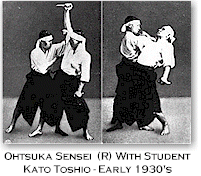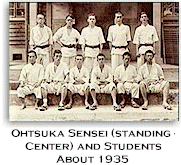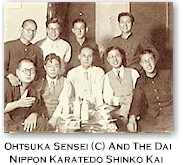Chapter
3  Rising Sun ~ Floating Moon Rising Sun ~ Floating Moon |
 |
As his skills increased, Ohtsuka Sensei began
to incorporate more and more of the practical concepts of Shindo Yoshin Ryu
Jujutsu, Aikido's spiritual principle of blending of Ki, along with the
influences of Kenwa Mabuni, Choki
 Motobu and other eminent karate sensei he
had trained with, into the karate classes Funakoshi-san had placed under his
instruction. Moreover, he did not limit his introduction of these new ideas
into basic techniques alone, but began to weave them into the very fabric of
Funakoshi's karate -- his kata. While many of the students under Ohtsuka
Sensei immediately saw the advantages, others saw something altogether
different; a dilution of their master's art. The most vocal of those was
Funakoshi's son, Yoshitaka, who wasted no time in informing his father
of what he believed was tantamount to an act of betrayal.
Motobu and other eminent karate sensei he
had trained with, into the karate classes Funakoshi-san had placed under his
instruction. Moreover, he did not limit his introduction of these new ideas
into basic techniques alone, but began to weave them into the very fabric of
Funakoshi's karate -- his kata. While many of the students under Ohtsuka
Sensei immediately saw the advantages, others saw something altogether
different; a dilution of their master's art. The most vocal of those was
Funakoshi's son, Yoshitaka, who wasted no time in informing his father
of what he believed was tantamount to an act of betrayal.
Although there are varying reports of the
factual sequence of events that occurred over the next period of time, it is
undisputed that Funakoshi viewed Ohtsuka Sensei's introduction of these new
ideas as intrinsically contrary to the core of his teachings, and publicly
criticized him for doing so. For Yoshitaka, however, his father's rebuke was
not nearly sufficient, calling for Ohtsuka's public expulsion, "...for
the good of the Shotokan movement."* While many martial arts
historians write that the two men's mutual admiration for each other remained
intact, it had become evident that Ohtsuka Sensei's reputation and style of
instruction had grown to not only rival that of Funakoshi's, but in the eyes
of many -- had surpassed the aging master's. For both, it was clear that the
road they had mutually traveled was diverging, and in 1930, Ohtsuka Sensei bid
farewell to Funakoshi-san's Dojo for the last time.
 Over the next four years, strengthened in
spirit by the number of students who followed him from Funakoshi-san's
Shotokan Ryu, Ohtsuka Sensei
continued to teach; establishing the primary techniques and kata of his
newly-evolving style, and registering as an independent member of the Nippon
Kobudo Shinko Kai - the Japan Martial Arts Research Association. Constantly
honing and refining the concepts that lay at the heart of the new Budo he
had envisioned years earlier, he focused much of his attention on applying
practical defense from formal art. It was during this period that the seeds of
his greatest contribution to the martial arts began to grow -- the Kihon
Kumite Katas. Originally 36 in number, the Kihon Kumite Katas were wholly
and completely Ohtsuka Sensei's -- in concept, development and application. In
blending the purest principles of Jujutsu, Aiki, and Karatedo, history would
show that he had created much more than simply 36 new kata. He had truly
created a new form of Budo -- a new karate -- that was greater than the sum of
its parts.
Over the next four years, strengthened in
spirit by the number of students who followed him from Funakoshi-san's
Shotokan Ryu, Ohtsuka Sensei
continued to teach; establishing the primary techniques and kata of his
newly-evolving style, and registering as an independent member of the Nippon
Kobudo Shinko Kai - the Japan Martial Arts Research Association. Constantly
honing and refining the concepts that lay at the heart of the new Budo he
had envisioned years earlier, he focused much of his attention on applying
practical defense from formal art. It was during this period that the seeds of
his greatest contribution to the martial arts began to grow -- the Kihon
Kumite Katas. Originally 36 in number, the Kihon Kumite Katas were wholly
and completely Ohtsuka Sensei's -- in concept, development and application. In
blending the purest principles of Jujutsu, Aiki, and Karatedo, history would
show that he had created much more than simply 36 new kata. He had truly
created a new form of Budo -- a new karate -- that was greater than the sum of
its parts.
 As word of his new style spread throughout the
martial arts community, so did Ohtsuka Sensei's reputation. In 1934,
encouraged by the number of young men seeking his instruction, he formed the Dai
Nippon Karatedo Shinko Kai (the All Japan Karatedo Research
Organization), the parent organization of today's Wado Ryu Karatedo Renmei. It was auspicious beginning in an important year -- for Ohtsuka Sensei
the karateka and Ohtsuka Hironori the man -- for 1934 was also the year
of the birth of his son, Jiro, his pride and heir apparent; the man who
would one day wear his father's Black Obi. Ironically, though, the Karatedo that had come to life through him that same year, was nameless. But true to
the old Zen proverb, that too would change.
As word of his new style spread throughout the
martial arts community, so did Ohtsuka Sensei's reputation. In 1934,
encouraged by the number of young men seeking his instruction, he formed the Dai
Nippon Karatedo Shinko Kai (the All Japan Karatedo Research
Organization), the parent organization of today's Wado Ryu Karatedo Renmei. It was auspicious beginning in an important year -- for Ohtsuka Sensei
the karateka and Ohtsuka Hironori the man -- for 1934 was also the year
of the birth of his son, Jiro, his pride and heir apparent; the man who
would one day wear his father's Black Obi. Ironically, though, the Karatedo that had come to life through him that same year, was nameless. But true to
the old Zen proverb, that too would change.
Late in the 1938, the Dai Nippon Kobudo Tai
Kai (the All Japan Classical Martial Arts Festival) invited Ohtsuka Sensei
to its Fall Festival, to demonstrate the style of karate that had become the
subject of so much discussion and controversy. When asked to name his style
prior to his demonstration, Ohtsuka was initially taken aback, never having
formally given a name to this new style. As legend has it, mere minutes before
his performance, he registered the name, "ShinShu Wado Ryu",
or, 'New Style Way of Harmony School". The following year, when the Dai
Nippon Butokukai requested that all martial arts in Japan formally
register their styles and chief instructors' names, Ohtsuka Sensei formally
registered the name Wado Ryu ~ Way of Peace and Harmony.
As
the years passed, Wado Ryu, like Ohtsuka Sensei himself, grew in prominence,
becoming one of the most highly regarded traditional martial arts in Japanese
culture. In 1966, that high regard was made manifest when Emperor Hirohito
himself awarded Ohtsuka Sensei with his homeland's highest honor -- The Kyuokujitsusho,
The Grand Order Of The Rising Sun -- presented for
his dedication to the introduction and teaching of Karatedo. In 1978, the
Royal Family's Higashi No Kuni no Miya, President of the prestigious
Kokusai Budo Renmei (International Martial Arts Federation) awarded Ohtsuka
Sensei the title of "Meijin", or 'Master'; the first such
honor ever bestowed upon a Karateka in Japan.
The contributions made by Hironori Ohtsuka
cannot be limited to the world of Karatedo, or even the larger world of
martial arts. More than one-hundred years after his birth, and nearly twenty
years since his passing, tens of thousands of people -- people from all walks
of life, of every faith and creed, and in every corner of the world, have, in
some way been affected by the simple, but powerful message that lay within the
core of his karate. A message that continues to be reflected in karateka
everywhere -- like the reflection of the moon, floating on the water.
"The Way is not meant as a way of
fighting. It is a path on which you travel to find your own inner peace and
harmony. It is yours to seek and find." Hironori Ohtsuka.
6.1.1892 ~ 1.29.1982